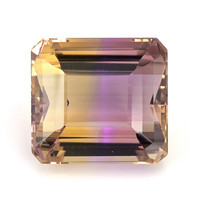Durability and Hardness of Ametrine
When choosing a gemstone for everyday wear, understanding the “durability and hardness of ametrine” is crucial. Ametrine, a unique blend of amethyst and citrine, offers not only stunning bi-color beauty but also remarkable resilience. The durability and hardness of ametrine make it an excellent choice for various types of jewelry, as it can withstand daily activities without easily scratching or chipping. Knowing about the durability and hardness of ametrine ensures that you can enjoy its vibrant hues and captivating charm for many years to come. Whether set in rings, pendants, or earrings, ametrine’s robustness is a testament to its exceptional quality and enduring appeal.

The Resilience of Ametrine: Navigating Durability and Hardness
In the enchanting world of gemstones, ametrine stands out not just for its captivating blend of purple and gold hues but also for its durability and hardness, essential factors that determine its suitability for various types of jewelry. This blog delves into the resilience of ametrine, exploring its physical characteristics, durability, and how these factors influence its use in jewelry designs. Understanding these aspects is crucial for collectors, jewelers, and anyone drawn to the unique beauty of this gemstone.
What Defines the Durability of Ametrine?
Durability in gemstones encompasses three main components: hardness, toughness, and stability. These factors collectively influence a gemstone’s ability to withstand wear, tear, pressure, and environmental factors.
Hardness: The Mohs Scale Measurement
Ametrine, like all quartz varieties, rates a 7 on the Mohs scale of hardness. This scale, ranging from 1 (talc) to 10 (diamond), measures a gemstone’s ability to resist scratches and abrasions. A rating of 7 means ametrine is relatively resistant to scratches from everyday items, making it suitable for a wide range of jewelry applications, including rings, pendants, and earrings. However, it’s worth noting that while ametrine can resist scratches from many substances, it’s not impervious to all forms of damage.
Toughness: Resistance to Breaking and Chipping
While hardness refers to a gemstone’s resistance to being scratched, toughness is about its ability to withstand impact. Ametrine has good toughness due to its crystalline structure, making it relatively resistant to chipping and breaking. However, like other quartz gems, it can still be vulnerable to sharp blows or extreme pressure, so careful handling and setting are important to prevent damage.
Stability: Withstanding Environmental Factors
Stability in gemstones refers to their ability to resist chemical reactions, temperature changes, and light exposure. Ametrine has high stability; it’s unlikely to react with most chemicals it encounters daily. It’s also stable under normal light exposure and temperatures. However, prolonged exposure to intense heat or direct sunlight should be avoided as it can cause fading or changes in color, especially in treated stones.
How to Maximize the Durability of Ametrine Jewelry
Given ametrine’s physical properties, several considerations can help maintain its beauty and integrity in jewelry:
- Setting Styles: Protective settings such as bezels or halo designs can shield ametrine from impacts and abrasion, enhancing its durability in everyday wear.
- Care and Maintenance: Regular cleaning with mild soap and water will keep ametrine jewelry looking its best. It’s also advisable to remove ametrine jewelry during strenuous activities to prevent accidental damage.
- Storage: When not in wear, ametrine jewelry should be stored separately from harder gemstones like diamonds to avoid scratches. Soft, padded jewelry boxes are ideal for storage.

Ametrine’s unique beauty, coupled with its respectable hardness and overall durability, makes it a sought-after choice for both jewelry enthusiasts and designers. While it requires some care to maintain its brilliance, the gemstone’s resilience makes it suitable for a variety of jewelry pieces that can be cherished for generations. By understanding and respecting the physical properties of ametrine, owners can enjoy the full splendor of this gemstone in their jewelry collections.
Please visit the link for more details about 4Cs Work Together in Ametrine!
